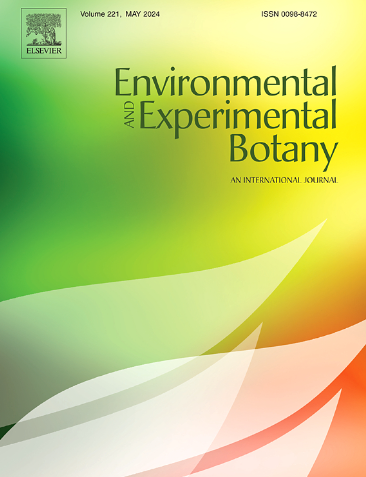茉莉酸甲酯通过介导高温胁迫对碳氮分配和利用的负面影响,调控穗部形态发生
IF 4.7
2区 生物学
Q2 ENVIRONMENTAL SCIENCES
引用次数: 0
摘要
高温胁迫对水稻穗部发育构成严重威胁。植物激素,包括茉莉酸(JA)在植物器官发育中起着重要作用。虽然已经研究了IAA、细胞分裂素和赤霉素在热胁迫中的作用,但对高温胁迫下水稻穗分化早期JA对穗形发生的影响的研究仍然有限。在本研究中,我们发现,在穗分化期,高温处理(昼/夜:38℃/ 29℃)显著降低了分化小穗数和每穗粒数。相关结果表明,这与抗氧化酶、碳氮代谢和内源激素有关,尤其是与碳氮代谢途径有关。高温胁迫限制了植株碳氮积累和再分配的速度,在控制条件下植株优先分配更多的碳氮给颖花发育。高温胁迫下JA合成和信号基因表达下调,导致内源JA和MeJA含量降低。外源MeJA处理通过显著提高硝酸盐还原酶、谷氨酰胺合成酶、谷氨酸合成酶、蔗糖合成酶和蔗糖磷酸合成酶的活性,优化了碳氮代谢。最终促进了穗部碳氮的积累和分配,极大地缓解了高温诱导的分化小花数和粒数减少。综上所述,我们的研究结果揭示了高温胁迫对小穗和穗发育的生理影响;但是,也建议HTS可以通过补充应用MeJA来缓解。本文章由计算机程序翻译,如有差异,请以英文原文为准。
Methyl jasmonate regulates panicle morphogenesis by mediating the negative effects of high temperature stress on carbon and nitrogen allocation and utilization
High-temperature stress (HTS) poses a serious threat to panicle development in rice. Plant hormones, including jasmonic acid (JA), play an important role in plant organ development. While the roles of IAA, cytokinin and gibberellin in heat stress have been studied, the research on JA in rice panicle morphogenesis under HTS during the early panicle differentiation period is still limited. In this study, we showed that HTS (day/night: 38℃ / 29℃) during the panicle differentiation period significantly reduced the number of differentiated spikelets and the number of grains per panicle. The correlation results suggest that this is related to antioxidant enzymes, carbon and nitrogen metabolism, and endogenous hormones, especially to carbon and nitrogen metabolism pathways. HTS limited the rate of carbon and nitrogen accumulation and redistribution in the plant, and the plant preferentially allocated more carbon and nitrogen to spikelets development under control conditions. The expression of JA synthesis and signaling genes was down-regulated under HTS, leading to a decrease in endogenous JA and MeJA content. Exogenous MeJA treatment optimized carbon and nitrogen metabolism by significantly enhancing the activities of nitrate reductase, glutamine synthetase, glutamate synthase, sucrose synthase, and sucrose phosphate synthase. Ultimately, the accumulation and allocation of carbon and nitrogen in panicle were improved, which greatly alleviated the high-temperature-induced decrease in differentiation spikelets and grain number. Overall, our results provide insight into the physiological effects of HTS during spikelets and panicle development; but, also suggest that HTS could be relieved with a supplemental application of MeJA.
求助全文
通过发布文献求助,成功后即可免费获取论文全文。
去求助
来源期刊

Environmental and Experimental Botany
环境科学-环境科学
CiteScore
9.30
自引率
5.30%
发文量
342
审稿时长
26 days
期刊介绍:
Environmental and Experimental Botany (EEB) publishes research papers on the physical, chemical, biological, molecular mechanisms and processes involved in the responses of plants to their environment.
In addition to research papers, the journal includes review articles. Submission is in agreement with the Editors-in-Chief.
The Journal also publishes special issues which are built by invited guest editors and are related to the main themes of EEB.
The areas covered by the Journal include:
(1) Responses of plants to heavy metals and pollutants
(2) Plant/water interactions (salinity, drought, flooding)
(3) Responses of plants to radiations ranging from UV-B to infrared
(4) Plant/atmosphere relations (ozone, CO2 , temperature)
(5) Global change impacts on plant ecophysiology
(6) Biotic interactions involving environmental factors.
 求助内容:
求助内容: 应助结果提醒方式:
应助结果提醒方式:


